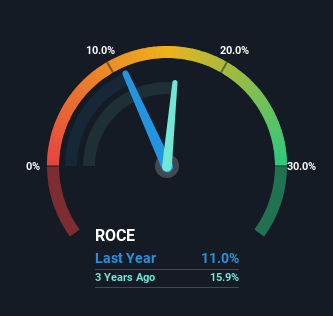- United States
- /
- Consumer Durables
- /
- NasdaqGS:LGIH
There Are Reasons To Feel Uneasy About LGI Homes' (NASDAQ:LGIH) Returns On Capital

Finding a business that has the potential to grow substantially is not easy, but it is possible if we look at a few key financial metrics. Typically, we'll want to notice a trend of growing return on capital employed (ROCE) and alongside that, an expanding base of capital employed. If you see this, it typically means it's a company with a great business model and plenty of profitable reinvestment opportunities. Having said that, from a first glance at LGI Homes (NASDAQ:LGIH) we aren't jumping out of our chairs at how returns are trending, but let's have a deeper look.
Return On Capital Employed (ROCE): What Is It?
For those that aren't sure what ROCE is, it measures the amount of pre-tax profits a company can generate from the capital employed in its business. To calculate this metric for LGI Homes, this is the formula:
Return on Capital Employed = Earnings Before Interest and Tax (EBIT) ÷ (Total Assets - Current Liabilities)
0.11 = US$327m ÷ (US$3.1b - US$120m) (Based on the trailing twelve months to March 2023).
Therefore, LGI Homes has an ROCE of 11%. In absolute terms, that's a pretty standard return but compared to the Consumer Durables industry average it falls behind.
See our latest analysis for LGI Homes

Above you can see how the current ROCE for LGI Homes compares to its prior returns on capital, but there's only so much you can tell from the past. If you'd like, you can check out the forecasts from the analysts covering LGI Homes here for free.
The Trend Of ROCE
On the surface, the trend of ROCE at LGI Homes doesn't inspire confidence. To be more specific, ROCE has fallen from 17% over the last five years. Given the business is employing more capital while revenue has slipped, this is a bit concerning. If this were to continue, you might be looking at a company that is trying to reinvest for growth but is actually losing market share since sales haven't increased.
The Key Takeaway
We're a bit apprehensive about LGI Homes because despite more capital being deployed in the business, returns on that capital and sales have both fallen. Yet despite these poor fundamentals, the stock has gained a huge 177% over the last five years, so investors appear very optimistic. In any case, the current underlying trends don't bode well for long term performance so unless they reverse, we'd start looking elsewhere.
On a separate note, we've found 1 warning sign for LGI Homes you'll probably want to know about.
While LGI Homes isn't earning the highest return, check out this free list of companies that are earning high returns on equity with solid balance sheets.
New: AI Stock Screener & Alerts
Our new AI Stock Screener scans the market every day to uncover opportunities.
• Dividend Powerhouses (3%+ Yield)
• Undervalued Small Caps with Insider Buying
• High growth Tech and AI Companies
Or build your own from over 50 metrics.
Have feedback on this article? Concerned about the content? Get in touch with us directly. Alternatively, email editorial-team (at) simplywallst.com.
This article by Simply Wall St is general in nature. We provide commentary based on historical data and analyst forecasts only using an unbiased methodology and our articles are not intended to be financial advice. It does not constitute a recommendation to buy or sell any stock, and does not take account of your objectives, or your financial situation. We aim to bring you long-term focused analysis driven by fundamental data. Note that our analysis may not factor in the latest price-sensitive company announcements or qualitative material. Simply Wall St has no position in any stocks mentioned.
About NasdaqGS:LGIH
LGI Homes
Engages in the design, construction, and sale of homes in the United States.
Mediocre balance sheet and slightly overvalued.

